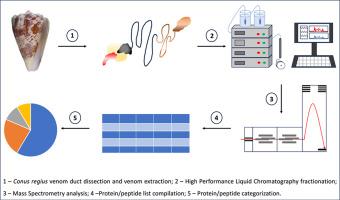Expanding the repertoire of conopeptides from the venom of the vermivorous snail Conus regius
IF 2.4
4区 医学
Q2 PHARMACOLOGY & PHARMACY
引用次数: 0
Abstract
This study presents a comprehensive proteomic characterization of Conus regius venom. Venom samples were fractionated using reversed-phase chromatography and analyzed by Q-TOF mass spectrometry. Spectral data were processed with Peaks Studio V7.0 and searched against a Conus protein database. A total of 520 peptide and protein sequences were identified, with most corresponding to conopeptides. Among these, eight presented similarities to disulfide-poor conopeptides of the Conantokin, ConoGay, and ConoCAP classes, as well as two sequences not classified in the literature. Additionally, 284 peptides showed similarity to conotoxins from 13 gene superfamilies (M, A, T, P, S, I1, Conodipine, O1, Insulin, G2, O2, Q, and H), while 102 sequences were linked to undetermined superfamilies. Of the identified sequences, 21 had been previously described in C. regius venom, while many others shared similarities with conotoxins from other Conus species. Most conotoxins identified were associated with the M and A superfamilies, suggesting their predominance in the venom. This study expands the known repertoire of C. regius venom components and provides valuable insights into its molecular diversity, supporting future research into its biotechnological potential.

扩展从蠕虫蜗牛Conus regius的毒液中提取的概念性肽
本研究提出了一个全面的蛋白质组学表征圆锥蛇毒液。毒液样品采用反相色谱法分离,Q-TOF质谱法分析。光谱数据使用Peaks Studio V7.0进行处理,并在Conus蛋白数据库中进行检索。共鉴定出520个肽和蛋白序列,其中大部分与conpeptide相对应。其中,8个序列与Conantokin、ConoGay和ConoCAP类的二硫化物贫肽相似,还有两个序列未在文献中分类。此外,284个序列与13个基因超家族(M、A、T、P、S、I1、Conodipine、O1、Insulin、G2、O2、Q和H)的conotoxins相似,102个序列与未确定的超家族相关。在已鉴定的序列中,有21个先前在C. regius毒液中被描述过,而其他许多序列与其他Conus物种的conotoxin有相似之处。大多数鉴定的concontoxins与M和A超家族有关,表明它们在毒液中占主导地位。这项研究扩大了已知的毒C. regius毒液成分,并为其分子多样性提供了有价值的见解,为未来对其生物技术潜力的研究提供了支持。
本文章由计算机程序翻译,如有差异,请以英文原文为准。
求助全文
约1分钟内获得全文
求助全文
来源期刊

Toxicon
医学-毒理学
CiteScore
4.80
自引率
10.70%
发文量
358
审稿时长
68 days
期刊介绍:
Toxicon has an open access mirror Toxicon: X, sharing the same aims and scope, editorial team, submission system and rigorous peer review. An introductory offer Toxicon: X - full waiver of the Open Access fee.
Toxicon''s "aims and scope" are to publish:
-articles containing the results of original research on problems related to toxins derived from animals, plants and microorganisms
-papers on novel findings related to the chemical, pharmacological, toxicological, and immunological properties of natural toxins
-molecular biological studies of toxins and other genes from poisonous and venomous organisms that advance understanding of the role or function of toxins
-clinical observations on poisoning and envenoming where a new therapeutic principle has been proposed or a decidedly superior clinical result has been obtained.
-material on the use of toxins as tools in studying biological processes and material on subjects related to venom and antivenom problems.
-articles on the translational application of toxins, for example as drugs and insecticides
-epidemiological studies on envenoming or poisoning, so long as they highlight a previously unrecognised medical problem or provide insight into the prevention or medical treatment of envenoming or poisoning. Retrospective surveys of hospital records, especially those lacking species identification, will not be considered for publication. Properly designed prospective community-based surveys are strongly encouraged.
-articles describing well-known activities of venoms, such as antibacterial, anticancer, and analgesic activities of arachnid venoms, without any attempt to define the mechanism of action or purify the active component, will not be considered for publication in Toxicon.
-review articles on problems related to toxinology.
To encourage the exchange of ideas, sections of the journal may be devoted to Short Communications, Letters to the Editor and activities of the affiliated societies.
 求助内容:
求助内容: 应助结果提醒方式:
应助结果提醒方式:


